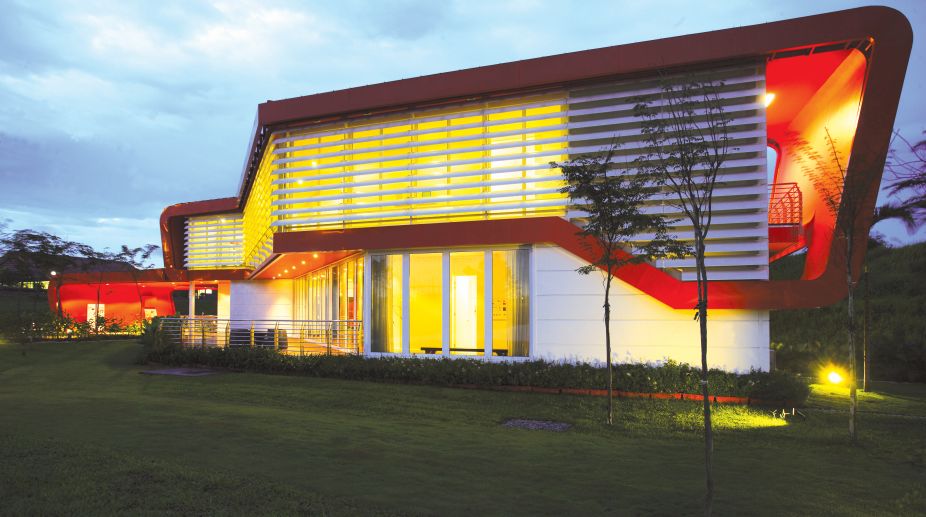An academic, author, television host and principal architect and founder of Pomeroy Studios, Jason Pomeroy is a multifaceted man. However, his passion for sustainable architecture remains consistent in whatever venture he undertakes.
The eco-architect helms his studio based in Singapore with a singular goal of bringing back the basic design principles of our ancestors. Pomeroy is convinced that this is the first step towards building sustainable urban growth.
Advertisement
After having designed Asia’s first carbon-neutral prototype home (The Idea House) in Malaysia and Asia’s first carbon-negative house (B-House) in Singapore, Pomeroy intends to take his sustainable design ideology to the next level by applying it on a mass scale to help build sustainable cities. Excerpts from an interview:
Q. Let’s talk about the B-House. How did you go about materialising this vision of a carbon negative house?
As with all of our projects, we seek to incorporate culture and heritage into the designs as much as possible. Our ancestors lived in an era before electricity and so developed passive design techniques into their homes. These techniques can be seen in the ancient Malay Kampong homes, whose high ceilings allowed air to circulate and cool, and their raised verandahs encouraged the cooling breeze to flow over nearby greenery. I drew on these to create Asia’s first carbon neutral prototype home — the Idea House — in Malaysia in 2010.
We also see this in the colonial Black and White bungalows prevalent in Singapore, which again, we used as inspiration for the B House, Singapore’s pioneering carbon negative home. The passive design techniques employed in the B House include a “form-matching-climate” approach that embraces the climatic conditions of the tropics (in which Singapore exists) in order to reduce energy and water use.
Q. Where does your ideology of returning to basic and sustainable design concepts stem from?
Two vivid memories stand out for me, the first is when I was a young boy playing in my parents’ garden in London, where I built a wigwam out of branches, leaves and old cloth — I believe that was my first foray into sustainable architecture!
Another memory is my first visit to Christopher Wren’s Baroque masterpiece – the St Pauls Cathedral in London. I remember being in awe of the lofty ceilings and magnificent structure. This passion stayed with me through my education, where I spent time at his other masterpiece, Trinity College Library whilst studying at Cambridge.
I spent my formative professional years in Hong Kong, among other places, where I was amazed at the way people lived so close together and yet it seemed to work. Despite the lack of space, the city created alternative social spaces, which formed the inspiration into my research into Skycourts and Skygardens as alternative vertical social spaces for the 21st century, and can be seen in many of our designs across the world.
Q. And what challenges do you think you’ll face when trying to apply such basic design principles on a mass scale?
In India, sustainable mass housing is an absolute necessity and I believe these same principles can be taken and applied on a larger scale. The current policy framework in India addresses affordable housing and green buildings as two separate issues.
Though urban housing policies and schemes refer to the need for exploring aspects of sustainability and innovation, these are not mandatory requirements to make sure they are implemented. I think this should change simply because it is absolutely possible to house people sustainably, and affordably.
Q. India’s urban population is set to rise by 404 million by 2050. More than 60 per cent of the country’s GDP comes from the urban sector and this is expected to only rise. What challenges do you foresee for building sustainable urban growth in a country like India?
India’s urban population is concentrated in its largest cities, and in cities with fewer than half a million residents. Only 27 per cent of the urban population lives in middle-tier cities, with populations between 500,000 and four million. A large share of India’s 115 million new non-farm jobs will be created in urban areas, but accommodating these new urban workers in India’s existing megacities will be a challenge.
Moreover, while urbanisation is facilitating the rise of the consuming class, it is not a panacea for India’s poverty.
Secondly, maintaining air and water quality is fast becoming the biggest urban problem. Cities are struggling with mountains of waste and looking for new models to manage it effectively. To enable sustainable urban prosperity, India’s cities will have to be converted to become more liveable places, with clean and green spaces. Housing provision for the growing urban population will also pose as a major challenge. The growing cost of houses in comparison to the income of the urban middle class has made it impossible for the majority of lower income groups to afford homes.
Q. How does Pomeroy Studio plan to address some of these larger challenges facing India as it rushes towards unbridled urbanisation?
I think one of the biggest challenges that I try to address, whether that is in my design studio, in the lecture theatre or in front of the TV camera, isn’t actually physical, but is changing people’s perception of what constitutes green cities, green buildings, and the green landscapes in which they sit. The stigma of green design costing 30 per cent more than normal buildings will continue to be challenged and de-mystified as green buildings are assessed in terms of their capital costs and operational costs in comparison to non-green buildings. In fact, green design is economic design.
We are continually de-mystifying the misconceptions about green architecture, and showing that sustainable design is cost effective, and works at the micro scale of a home to the macro-scale of an entire city. There is an awakening that the costs initially associated with green design are marginal (one to five per cent over non-green buildings) and yet the upsides considerably outweigh the former.
A perfect example is the B House, Singapore’s pioneering operational carbon-negative home that Pomeroy Studio designed in 2016. It generates more green energy than it consumes, costs the same as a conventional house in the area, and draws on many of the passive design techniques used in Singapore’s iconic Black and White colonial bungalows. The same can be done in India at an affordable price point.
Q. For an environmentally apathetic India, how can sustainable architecture help combat climate change?
Sustainable design seeks to minimise waste and redundancy in the design of the spaces, the structure and water and energy requirements. The traditional vernacular architecture of India is replete with techniques that we can borrow and apply today. Not only can these techniques, when applied today, reduce energy use, they can help reduce pollution and waste. So, the basics are there in terms of local vernacular architectural techniques. But the next phase is in persuading developers, policy-makers and citizens that sustainable architecture will not only help combat climate change, but will result in more pleasant, liveable cities.
We could continue along our current trends of focusing on cost and quantity, de-emphasising energy efficiency and sustainability, or we could design buildings that rely less on carbon-emitting energy sources, and make best use of natural light, ventilation and foliage. By simply adhering to some of the passive design techniques piloted by our ancestors, we can significantly reduce energy usage without raising construction costs.
















